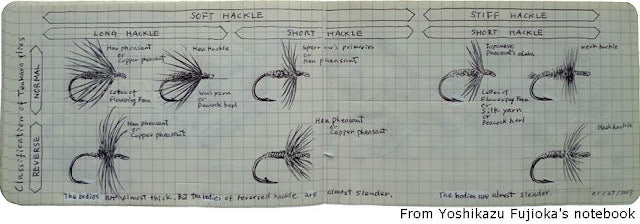While we subscribe to the theory that fishing is extremely simple, and that a person can successfully fish with one fly pattern, whatever pattern they choose, we also really like tenkara flies. They come in different shapes, colors, sizes and with unique details about each of them. Due to the research and interest of Mr. Yoshikazu Fujioka, from the website "My Best Mountain Streams", we have been able to learn a lot about tenkara flies, their geographic origins and some of their history.
Mr. Fujioka is our tenkara fly teacher, our tenkara kebari <em>sensei</em>, and also helped us put together our current selection of flies. Over the years he has researched and collected traditional tenkara flies from different regions of Japan. Now, Fujioka <em>sensei</em> gives us a very nice, yet, tenkara-like simple, analysis of tenkara flies. Like classifying western flies into "dry", "wet", "nymphs", etc, his analysis focuses specifically on tenkara flies and what pattern styles are commonly found in the hands of tenkara anglers. These should serve as a good foundation to better understanding tenkara flies (if one chooses to, understanding this is not really necessary to be a successful angler).
While the most characteristic tenkara flies are the so-called "sakasa kebari", or reverse hackle flies, these are not the only type of fly used in tenkara, and as shown in his graphic chart, even the sakasa kebari come in different forms and with different characteristics (soft hackle/stiff hackle, thick body/thin body and short/long hackle).
Typically, an experienced tenkara angler will use one pattern only. Over time, an angler will acquire preferences for a specific fly type, and will have his "go-to" fly. Not all tenkara anglers use the same fly as each other, but each one tends to stick with only one style. Some may believe a fly with soft hackle will be more "fluid", softer and thus may be more attractive; other people may believe a stiffer hackle facing forward is better at attracting fish. Yet, others will tie any fly they find to be the simplest and quickest to tie. This is what Fujioka <em>sensei</em> shows in his analysis of tenkara flies.
